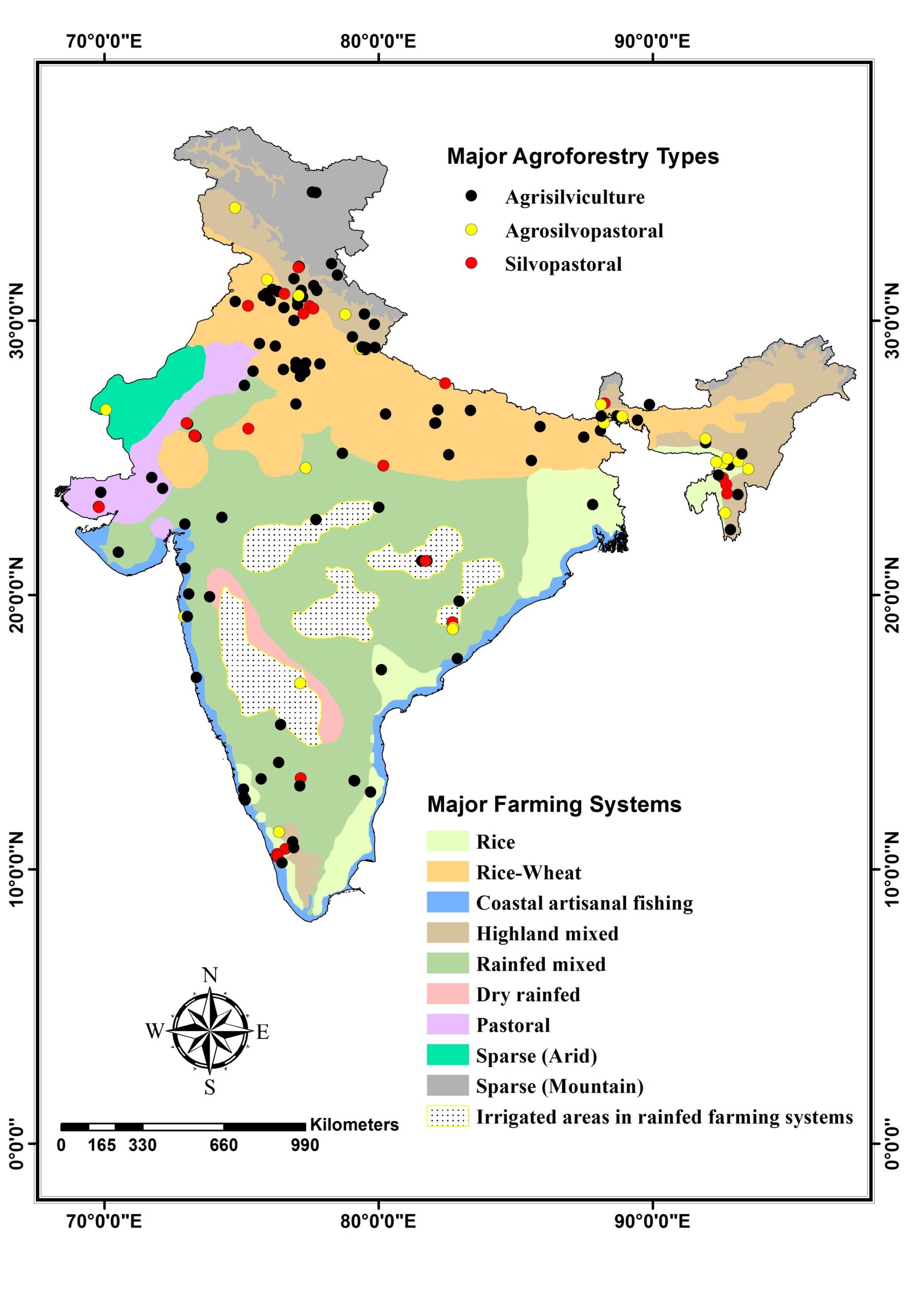
Expanding the land area under agroforestry systems, which integrate trees alongside crops, is a promising strategy to offset greenhouse gas emissions and could help achieve India’s Nationally Determined Contributions to the United Nations Framework Convention on Climate Change, reveals a study.
The study authors recommend that agroforestry should be included as a mitigation strategy in India’s Nationally Determined Contributions (NDCs) to the United Nations Framework Convention on Climate Change (UNFCCC). Boosting the area under agroforestry can also contribute to the National Mission for a Green India under the National Action Plan on Climate Change 2011 and the National Forest Policy 2018, stress the authors.
In 2019, India ranked third in greenhouse gas emissions after China and the United States. The largest contributors to India’s emissions have historically been energy, agriculture, industry and municipal waste. Under the Paris Agreement, India pledged to cut its greenhouse gas emissions intensity by 33 to 35 percent from 2005 levels by 2030. To achieve this, India aims to increase the share of non-fossil fuel-based power and create an additional carbon sink through afforestation.
Agroforestry systems, which integrate trees in agricultural landscapes, have been recognised by scientists for their role in mitigating climate change by acting as a carbon sink: trees sequester atmospheric carbon in their biomass. Agroforestry practices can also enhance soil organic carbon, which is a component of soil organic matter and is the largest carbon stock in terrestrial ecosystems. What’s more, these systems provide additional benefits such as improving soil health, advancing food security, supporting livelihoods, reducing biodiversity losses and the rate of land degradation, among others. Consequently, experts believe that agroforestry could be a win-win solution.
Recognising the potential of agroforestry in meeting various developmental and environmental goals, India launched a National Agroforestry Policy in 2014. By increasing the area under agroforestry, the policy aims to address the increasing demand for timber, food, fuel, fodder, fertiliser and fibre whilst creating employment and generating income.
Humid zones and agrosilvopastoral systems store most carbon
A 2019 study coauthored by Firoz Ahmad, a scientific advisor at the Mirzapur-based Vindhyan Ecology and Natural History Foundation, reported that of the 52 percent of land under agriculture in India, 46 percent has a high potential for agroforestry. Delineating the climatic zones of India which are suitable for agroforestry, the study found that 60 percent of coastal, 40 percent of humid, 56 percent of sub-humid, 31 percent of semi-arid and 2.8 percent of the land in arid areas are highly suitable for agroforestry.

The present study assessed the potential of agroforestry systems in sequestering carbon in the different climatic and altitudinal zones of India. Data from previous studies were used for aboveground biomass and soil organic carbon (30cm below soil). Below ground biomass was calculated based on IPCC guidelines.
Agroforestry practices in India’s humid zones had higher total biomass carbon stocks (97.9 Megagram Carbon per hectare or Mg C/ha) and soil organic carbon stocks (51.8 Mg C/ha) than all other zones. The lowest biomass carbon stocks were in the sub-humid zones (32.5 Mg C/ha) while the semiarid zones had the lowest soil organic carbon stocks (26.8 Mg C/ha). Medium altitudes (800-1900 metres above sea level) had higher soil organic carbon stocks (51.2 Mg C/ha) under agroforestry than high (46.7 Mg C/ha) and low altitudes (32.7 Mg C/ha).
“Humid zones are characterised by higher humidity,” which makes “plants more efficient at drawing in carbon,” explained Arun Jyoti Nath, assistant professor at Assam University, Silchar, India, and an author of the study.

Among three different types of agroforestry practices, the researchers found that agrosilvopastoral systems (which integrate crops, trees and livestock) had the highest biomass carbon stocks and soil organic carbon than agrisilvicultural (crops and trees) and silvopastoral (trees and livestock) systems.
“The variation in biomass carbon stock and soil organic carbon is due to the climatic factors, choice of tree species, tree density, silvicultural management practices and type of soil,” explained Sangram Chavan, a scientist specialising in agroforestry at the Indian Council of Agricultural Research-National Institute of Abiotic Stress Management. According to a 2016 study he co-authored, existing agroforestry systems on farmers’ fields in India can mitigate 109 million tons of CO2 annually, which may offset 33 percent of the total greenhouse gas emissions from the agriculture sector.
Agrosilvopastoral systems cover an estimated land area of 5.58 million hectares in India. An excellent example of agrosilvopastoral systems in India are home gardens, note the researchers. “These are a common practice in northeastern states like Assam and Tripura, West Bengal and parts of the Andaman and Nicobar Islands, the southern states especially Kerala and Tamil Nadu,” the authors stated. “In agrosilvopastoral systems, farmers manage plants of different use-values (fruits, fodder, timber, fuelwood) that leads to high stand density and therefore more biomass carbon storage,” explained Nath.
Meeting multiple goals
The researchers projected the carbon sequestration potential of the three agroforestry systems under two scenarios: the first is business-as-usual with no change in the area of agroforestry while the other entails a five percent increase in the area under agroforestry every five years starting from 2020. They also estimated India’s total projected emissions for 2030 and 2050 using data from the Food and Agriculture Organisation of the United Nations.
By increasing the area under all agroforestry systems from the existing 16.7 million hectares (ha) in the first scenario to 21.3 million ha in the second scenario by 2050 the total carbon sequestered rises from 10.5 to 13.6 Petagrams CO2 eq (Pg CO2 eq).
In the business-as-usual scenario, the carbon sequestered by 2030 (7.4 Pg CO2 eq) is greater than India’s projected greenhouse gas emissions for 2030 (3.8–5.3 Pg CO2 eq). According to the authors, this implies that India could potentially earn revenues through selling international carbon credits from the excess carbon sequestered.
With a five-percent increase in current area under agroforestry at 5-years intervals, the estimated total carbon sequestered in 2050 (13.6 Pg CO2 eq) exceeds India’s total projected emissions for 2050 (11.46 Pg CO2 eq). In other words, a 30-percent increase in the area under agroforestry by 2050 could offset India’s projected emissions from energy, agriculture and industrial processes. In comparison, the total carbon sequestered by 2050 in the business-as-usual scenario (10.5 Pg CO2 eq) falls short of India’s projected emissions (11.46 Pg CO2 eq).
Variabilities exist in the sampling method used in the study, which can underestimate the carbon potential in the scenarios projected, said Chavan, who was not connected to the study. Destructive sampling through the harvesting of trees can provide a more accurate estimate of carbon storage potential, which Chavan said is required for Nationally Determined Contributions.
It is better to consider “agroforestry as a way to offset the emissions of past land-use change rather than of future fossil fuel emissions,” Forrest Fleischman, assistant professor at the University of Minnesota, pointed out. “In most Indian contexts, land that could be converted to agroforestry is land that is currently under annual crops, but was historically forest or savanna. When it was converted to agriculture, there were carbon emissions associated with the disruption of natural ecosystems,” he explained.
Ahmad, who was not involved in the present study, says that implementing agroforestry at various landscape domains can be the best tactic to reach the Indian government’s target of increasing an additional carbon sink of 2.5 to 3 Pg CO2 eq through afforestation. “India needs to maneuver its agroforestry policy towards achieving a broader spectrum of Sustainable Development Goals linked to poverty mitigation, livelihood initiation, environmental safeguarding, biodiversity conservation and transformation to climate change,” added Ahmad.

Chavan agrees, stating that agroforestry can play a major role in achieving at least nine out of 17 of the Sustainable Development Goals established by the United Nations in 2015. He adds that prior to the Paris Agreement, the Indian government initiated various policies to increase the green cover of the country such as the Green India Mission 2003, plantation drives through Compensatory Afforestation Fund Management and Planning Authority (CAMPA) and the National Agroforestry Policy of 2014. But there are numerous hurdles in scaling up agroforestry practices. “Lack of sufficient qualitative planting material, inadequate market facility or infrastructure and poor institutional support,” are some issues that need to be addressed, noted Ahmad. With the implementation of supportive policies, Nath believes expansion is possible.
CITATION:
Nath, A. J., Sileshi, G. W., Laskar, S. Y., Pathak, K., Reang, D., Nath, A., & Das, A. K. (2021). Quantifying carbon stocks and sequestration potential in agroforestry systems under divergent management scenarios relevant to India’s Nationally Determined Contribution. Journal of Cleaner Production, 281, 124831.
The article has been authored by Neha Jain. The article originally appeared in Mongabay.












